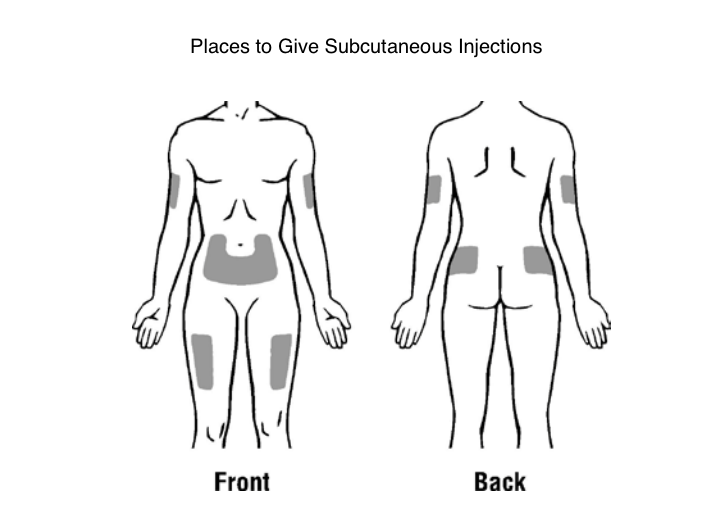How To Give a Subcutaneous (SubQ or SQ) Injection
A subcutaneous injection is a way to give certain medications using a needle. The subcutaneous (SubQ or SQ) tissue, also known as the hypodermis, is the innermost (deepest) layer of skin. It is made up of fat and connective tissue and helps the body control temperature. Medication is absorbed (taken in) more slowly when it is given into the subcutaneous tissue rather than into a vein (IV) or muscle (IM). Medications that can be given subcutaneously are insulin, some hormones, blood thinners, and medications that stimulate (rev up) blood cell production, such as filgrastim (Neupogen).
If you need to give yourself a subcutaneous injection, your provider will teach you how to do so. In some cases, you will need to draw up the medication yourself. This means that you have a vial or bottle that has the medicine in it and you will need to get the correct dose into the needle. Many medications now come ready with the dose already in the syringe. Insulin often comes in a device that looks like a pen. In this case, you attach the needle to a pen, click to the dose you want, and then give the medication.
If you have questions about how to draw up the correct dose, please ask your pharmacist or provider. Ask your pharmacist how the medication should be stored. If it is stored in a refrigerator, remove it 30 minutes before injecting it. Your provider may tell you where on your body you should inject the medication.
How to give the injection
First, you need to clean your hands. Use soap and warm water and clean between the fingers, backs of the hands, wrists, fingernails, and under the fingernails for at least 20 seconds. Dry your hands with a clean towel or paper towel.
1. Gather all of the supplies that you need
Make sure you have a clear and clean counter space for your supplies. Your supplies will be:
- The needle and syringe with the medication or the auto-injector pen. You should always double-check that you have the correct medication and dose ready.
- Alcohol pads to clean the area where you will give the injection. One pad is usually enough to clean the area, but it is always good to have an extra in case you need it.
- Gauze can be used to put pressure on the injection site after injecting if you tend to bleed.
- A puncture-resistant container (sharps container) to throw away the needle and syringe after it has been used. Have this close by so you can throw the syringe and needle away right after your injection.
- A band-aid or bandage in case you want to cover the area where the injection was given.
2. Find a spot and clean it
There are certain spots on your body where subcutaneous injections should be given. These tend to be places where you can easily access the subcutaneous (fatty areas) under the skin and the needle won't come too close to muscle or bone. The sites are:
- The lower part of your belly. Stay 2 inches away from your belly button.
- The side or back of your upper arms.
- The front of your thighs.
- If someone else is giving you the injection, they may use your lower back.
Some people have more subcutaneous tissue than others. Try to find a spot where you are able to pinch the skin away from your body. You also want to choose a spot that is not reddened or hard. Change where you give your injection each time. Once you have chosen a site, use the alcohol pad to clean it. Let the alcohol dry on its own. Do not blow on it or wipe away the alcohol.
3. Inject the medication
You may have a hard time the first time you give yourself a subcutaneous injection. Your hands may be shaky and you may be nervous. Take a few deep breaths - it will get easier the more times you do it. Find what works for you. In general:
- Take your thumb and index (pointer) finger and pinch the skin. Lift the skin away from your body. Pinching and pulling gently will pull the subcutaneous tissue away from the muscle.
- Remove the safety cover from the needle if there is one. Poke the needle straight into the skin you are pinching. The needle can be inserted at a 90-degree angle (straight in, somewhat like a dart) or at a 45-degree angle. Once the needle is in, you can let go of your skin (unpinch it).
- Slowly push the plunger on the syringe to push the medication into your subcutaneous tissue.
- Once all of the medication goes in, take the needle out. If there is a safety device on the needle, put it in place it right away.
- Place the needle into the puncture-resistant (sharps) container.
- Use the gauze to put light pressure on the site. You can put a band-aid or bandage on the site if it bleeds. You may have some bruising.
A nurse or provider will walk you through how to give yourself or a loved on a subcutaneuous injection. Ask questions. It may be helpful to do the first injection with your provider. It can be hard to give yourself an injection, but with some practice, it will become easier.
References
MedlinePlus. Bethesda (MD): National Library of Medicine (US). Subcutaneous (SQ) injections [updated 2023 Oct 28. Available from: https://medlineplus.gov/ency/patientinstructions/000430.htm
Usach I, Martinez R, Festini T, Peris JE. Subcutaneous Injection of Drugs: Literature Review of Factors Influencing Pain Sensation at the Injection Site. Adv Ther. 2019 Nov;36(11):2986-2996. doi: 10.1007/s12325-019-01101-6. Epub 2019 Oct 5. PMID: 31587143; PMCID: PMC6822791.
Valentin VL. Injections. In: Dehn R, Asprey D, eds. Essential Clinical Procedures. 4th ed. Philadelphia, PA: Elsevier; 2021:chap 13.
